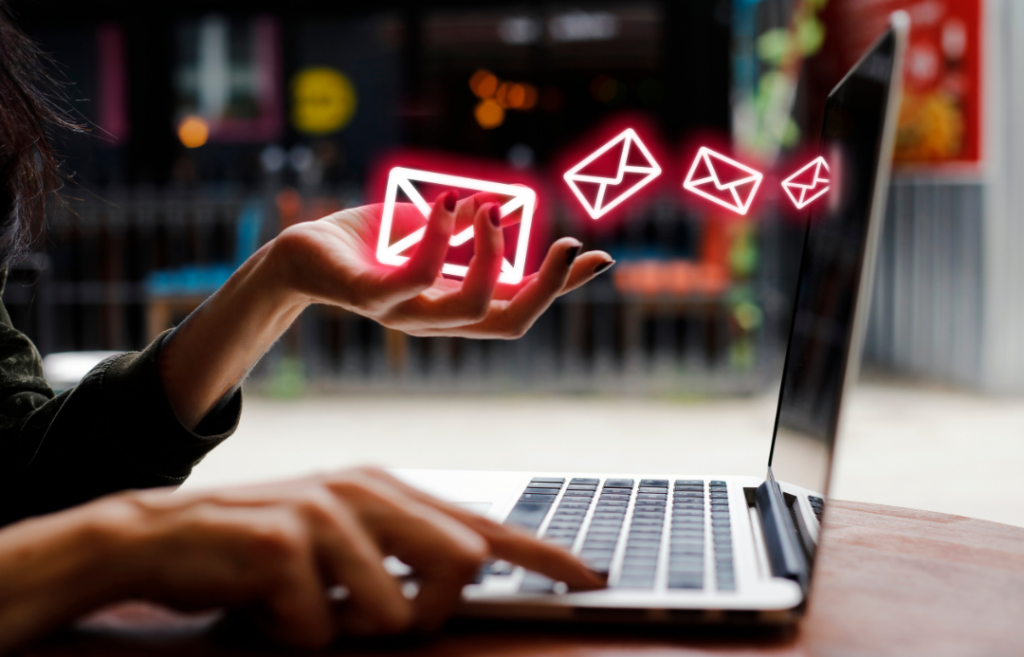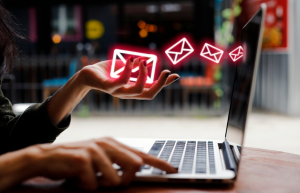When people think of personalization, they usually think of digital personalization, rather than implementation via offline channels. The customer, however, wants a problem-free customer experience, regardless of when, where, and on which device or via which channel or touchpoint of the customer journey it takes place. In other words, consistent personalization in all areas of customer contact.
According to a survey by absolit, almost all respondents now use the possibilities of personalized communication. More than half, however, use only online channels for this purpose. Less than half of the respondents use a combination of online and offline for personalization. So when developing your personalization strategy, think about your offline measures as well! The leverage of online and offline measures further strengthens the effect of personalization.
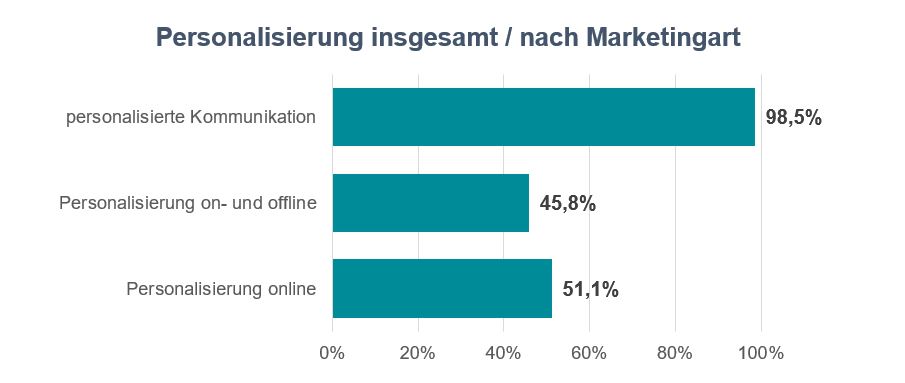
Tip: A good option is, for example, a postal mailing combined with a personalized URL, a so-called PURL (Personalized Unique Resource Locator).
Come closer… can we find touch points?
Addressing the customer by name in the e-mail newsletter has become such an elementary requirement that you might almost think it’s not part of personalization. For example, because customers only ever see their “own personalized” view of a website or online store, they probably don’t notice: more and more digital content and areas are personalized. In the best case, they do not even perceive personalization as such.
In addition to the touchpoints just mentioned, companies have a wide range of options for personalized dialog with customers. To develop your personalization strategy, you should list all the touchpoints with your customers – be it marketing measures, website/onsite, order management, customer service or after-sales, etc.
Does your existing customer communication already include personalized content? What measures do you see in the various channels – online/offline?
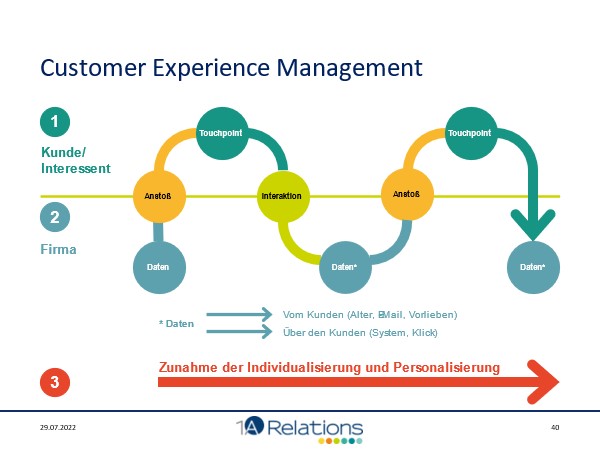
With the above chart, it is first of all unimportant whether off or online. The main thing is to use each contact to collect data in a meaningful and transparent way and to use it for the next contact. In the jargon one often speaks of Next Best Action (NBA) or Next Best Offer (NBO). These upcoming communication pushes become more targeted and responsive as more of your own data is used….
Don’t forget about perhaps more unusual touchpoints (POS, phone, live chat, surveys…), even though email and website are considered by far the most effective channels for digital personalization by respondents, according to a study by Ascend.
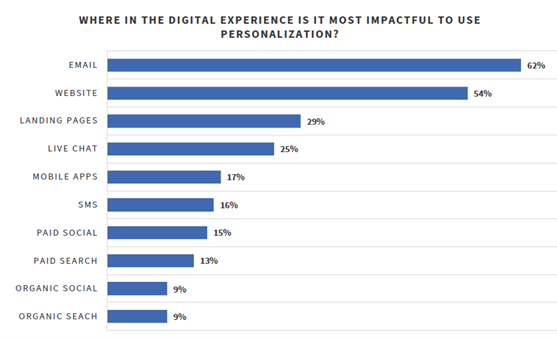
It’s just a matter of getting the customization right….
Which elements in the field of e-mail and website can be personalized? Here is a list of possibilities (not exhaustive):
- Localized websites for different countries/languages
- Customized display of ads or content, depending on local time, local weather, or which node is used to access the email.
- Different prices, e.g. for private and business customers
All other points can be found in the whitepaper “The Personalization Handbook”. Download now for free and get all contents and all 5 parts compactly in one ePaper:
if the data is right…
The data for such personalization of one’s own website or digital channels can be obtained, for example, by collecting the following parameters (without claiming completeness):
- Behavioral data, quantitative: page views, surfing behavior, history, bounce rate, click rate, etc.
- Behavioral data, qualitative: heat maps, cursor tracking, dead clicks, rage clicks, etc.
- Open rates, subscribe/unsubscribe rates.
The other points can be found in the whitepaper.
Content – the personalized challenge
Without data, no personalized content – without personalized content, no data.
In fact, it’s like the chicken and egg problem, one is not possible without the other. Personalized content is the criterion with which a company can stand out from the crowd, given the abundance of content to which a (potential) customer is permanently and excessively exposed, especially on digital channels.
However, the more complex the customer journey and the more heterogeneous the target group, the more difficult it can be to provide personalized content. It takes a lot of time and effort to provide personalized content variations that are tailored to different people, touchpoints, and customer journeys.
Therefore, the design usually starts simple, with 2-3 variations, for example. This always includes the “chicken-way.” That means, for all persons, to whom the personalized variants do not apply, they go through at least one standard (chicken way). This is necessary so that nobody runs into a communicative dead end (wrong or 404 pages).
It is not only the content, which may have to be thematically different, that is a challenge; it is also necessary to provide personalized content throughout the entire customer life cycle. To do this, the content – and also the data – must be constantly adapted and optimized.
If personalization is not seen as a permanent process (including a data and qualification strategy as well as incentives for employees to engage in qualification work), with an always up-to-date database and content adapted to changing usage behavior, customers will not feel that they are being met.

Technology as a helper
The increasing complexity due to more and more personalization can hardly be managed by pure manpower. What helps are appropriate structures and processes and technical support. Without technological support, it is hardly possible to individualize content in such a way that only certain target segments are actually addressed.
A Content Services Platform (CSP) can streamline and facilitate the process of content creation and delivery of omnichannel personalization. The platform centrally manages numerous services related to content creation, management, and processing.
A content services platform (CSP) consists of a set of services and microservices in the form of an integrated product suite and applications that share common APIs and storage. A CSP leverages different content types and serves multiple audiences and numerous use cases across an organization. – Gartner
Source: https://www.gartner.com/en/information-technology/glossary/content-services-platform-csp
Technologies such as artificial intelligence (AI), big data, and analytics software are already being used to personalize content. The media company IDG, for example, is a pioneer here. The technical possibilities are now so well developed that automated personalization of digital content along the customer journey is possible in content distribution.
Personalization manually or by machine?
The use of AI for personalization is …
All parts and the full article can be found in the free ePaper:
Click here for part 1, part 2 or part 3
Note: This is a machine translation. It is neither 100% complete or 100% correct. We can therefore not guarantee the result.








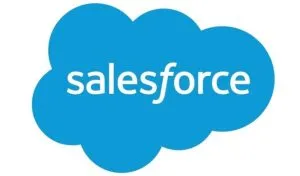

 CAS Software AG ist Marktführer für Kundenbeziehungsmanagement (CRM) im deutschen Mittelstand. Ob Marketing, Vertrieb oder Service – Anwender profitieren von effizienten Prozessen auf einer einheitlichen Datenbasis.
CAS Software AG ist Marktführer für Kundenbeziehungsmanagement (CRM) im deutschen Mittelstand. Ob Marketing, Vertrieb oder Service – Anwender profitieren von effizienten Prozessen auf einer einheitlichen Datenbasis.
